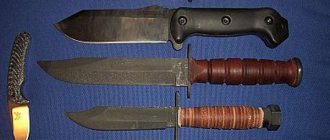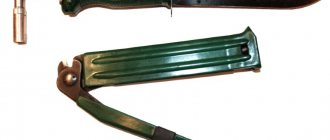We finish the conversation about how to wield a sword, ax, spear without legal consequences. We started it in the article at the link by talking about definitions that operate in the right sphere. Now let's look at the main stages of turnover of historical refrigerated goods from acquisition to disposal.
But first, a few words about bladed weapons that have been withdrawn from circulation - that is, those that should not exist on Russian territory at all. This includes flails, brass knuckles, shurikens (“ninja stars”), boomerangs and other objects specially adapted for use as weapons with impact, crushing and throwing action. With the exception of sports equipment. The basis is the Federal Law “On Weapons”.
As already mentioned, we will not talk about throwing weapons here. As for the rest, the wording of the law in this case is very unambiguous: a huge layer of impact weapons in our country has turned out to be illegal.
And disguising, for example, a flail as sports equipment is unlikely to help and will raise reasonable questions, since there is absolutely no need for sports equipment to copy in detail what appears to be a historical weapon.
In this regard, offers to sell such items (brass knuckles and batons, for example), especially with advance payment and ordering from abroad, are most often a deception and a scam. And if you manage to acquire something similar, then law enforcement agencies will take it away on occasion.
So…
1.1. What do you need to purchase copies and replicas of antique weapons?
Therefore, antique edged weapons can be purchased without a license or other permission. Apparently, this is due to the fact that antique weapons pose little danger nationwide. The fact is that, by definition, there is little of it left, it is expensive, often in poor condition and, thus, is, first of all, of cultural value.
To purchase copies and replicas of antique weapons, you must have a license for collecting weapons, which will indicate which weapons it gives the right to collect.
Having received the appropriate license, you can purchase copies and replicas of antique edged weapons in unlimited quantities. But on the condition that they will all be certified as such.
At the same time, the need to obtain a collecting license is not related to achieving a certain number of copies and replicas you already have. A license must be issued for any number of them, because It is not allowed to own copies and replicas of antique edged weapons in any quantity without it.
To accept copies and replicas of bladed weapons as a gift or by inheritance, you will also have to acquire a collecting license, unlike, again, the originals, which do not require any permits for acquisition.
However, due to the clumsiness of the current legislation in this matter, you should be prepared for the fact that you will not be given a gift and inheritance just like that, you will have to run around and fill out a bunch of extra papers.
There is no need to register an existing historical cold spot with the internal affairs bodies.
Greek fire
A flammable mixture used for military purposes during the Middle Ages. It was first used by the Byzantines in naval battles. The installation with Greek fire was a copper pipe - a siphon, through which the liquid mixture erupted with a roar. Compressed air or bellows like blacksmith's were used as buoyant force.
Presumably, the maximum range of siphons was 25–30 m, so initially Greek fire was used only in the navy, where it posed a terrible threat to the slow and clumsy wooden ships of the time. In addition, according to contemporaries, the Greek fire could not be extinguished by anything, since it continued to burn even on the surface of the water.
1.2. License to manufacture weapons
To make bladed weapons yourself, you also need to have a license, but a different one – for manufacturing.
Here it should immediately be noted that the manufacture of edged weapons, as again clarified by the Plenum of the Supreme Court of the Russian Federation, should be understood as their creation, including by altering any other objects, as a result of which they acquire the properties of edged weapons.
That is, in our case this means the following. Suppose you, without a manufacturing license, sharpen a sword. At the same time, the sword has a certificate stating that it is not a bladed weapon due to the lack of a blade. In this case, you risk being charged with a criminal offense for illegally manufacturing bladed weapons.
So be careful.
By the way, the same applies to pole weapons: according to the logic of the law, if you simply take and sharpen a small (!) spear tip, then you will not make a weapon in this way. But if you put it on a shaft, you will become a manufacturer of a full-fledged spear.
In general, we should not forget that, often, individual parts of a weapon do not raise any questions, and only connecting them together can become an illegal act. A typical example is the flail, which is banned in Russia.
Separately from the stick and rope, the weight (beat) does not contain anything illegal, and offers for their sale are found quite often on the Internet. But anyone who makes a full-fledged flail using this weight will become a criminal, because the parts are combined into a whole, and this very whole is prohibited in our country.
1.3. Is it worth buying a sword abroad?
Separately, it is worth mentioning the import into Russia of historical edged weapons purchased abroad. In short: whether or not to engage in such things is up to you.
Of course, there is a certain procedure, however, even if you follow it, importing weapons is a lottery: either it will go through without problems, or you will have to drag around for a long time through authorities, spend a lot of money, and in the end, perhaps, you will never receive an import permit. There can be a lot of options, so before you start this, you should thoroughly study this very voluminous issue, as well as stock up on money and patience.
Contents
- 1 Weapons 1.1 Melee 1.1.1 Axes
- 1.1.2 Long crushing
- 1.1.3 Short crushing
- 1.1.4 Long cutting
- 1.1.5 Short cutting
- 1.1.6 Spears
- 1.1.7 Improvised
- 1.1.8 Pistols
- 1.1.9 Shotguns
- 1.1.10 Rifles
- 1.1.11 Build 39 1.1.11.1 Clubs
- 1.1.11.2 Piercing and cutting
- 1.1.11.3 Other
- 1.1.11.4 Long-range
- 1.1.11.5 Cartridges
- 1.1.11.6 Small arms
- 1.1.11.7 Modifications of small arms 1.1.11.7.1 Canons
- 1.1.11.7.2 Return spring
- 1.1.11.7.3 Sights
- 1.1.11.7.4 Belts and bandoliers
- 1.1.11.7.5 Stock
Wearing.
The carrying of bladed weapons by citizens for self-defense, except in cases of transport or transport, is prohibited. Provided that it is not a reward, of course. Antique weapons, as well as their copies and replicas, can also be awarded (but a separate permit is issued for this).
Actually, it is difficult to imagine everyday wearing of it by citizens for any other purpose - it is, after all, a weapon. It is unlikely that you will be able to convince anyone that you are wearing a sword for beauty. Especially if it is a fighting sword, and not a prop, which would be quite enough for beauty, if you have such a specific taste.
In addition to self-defense, there is another option in which the presence of a sword, skramasax or falchion in the hands of a citizen looks quite appropriate - this is a historical reconstruction that is relevant for many readers of Ludota.
Here the law is no longer so clear.
Carrying and using (of course, not for killing or wounding) copies (in the sense of similarities), as well as replicas of antique weapons, plus the wearing of antique weapons themselves, is permitted only with historical costumes.
But only during the participation of citizens in historical, cultural or other events held by a certain number of organizations. These include:
- federal executive authorities,
- executive authorities of the constituent entities of the Russian Federation,
- museums,
- state or public cultural and educational organizations and associations.
But! Subject to coordination of the said events with the Ministry of Culture of the Russian Federation and the Ministry of Internal Affairs of the Russian Federation.
It is clear that obtaining all approvals and permits is a tedious task, so festivals can be held without them. Their absence does not hinder the holding of events, but there is a significant caveat: there should not be weapons there.
In this regard, the Federal Law “On Weapons” contains a general clause: “ Citizens are not allowed to carry weapons during rallies, street processions, demonstrations, picketing and other mass public events .”
Historical festivals fall well into the category of “other mass public events”.
Therefore, all that remains is to state what is already well known to fans of historical reconstruction: you should come to such events without weapons. Not in the sense of “coming empty-handed,” but in the sense of “coming with something that is not a weapon.”
Impact weapons from the point of view of the law
Swords without a blade and spears without a point have already been discussed above; this also partially applies to cutting weapons (although, again, for reliability it is better to obtain an expert opinion or certificate).
It is much more difficult with impact-crushing weapons, which have neither a blade nor a point. As mentioned above, it has been completely withdrawn from circulation in Russia, but without pernachs or war hammers, historical reconstruction will often be clearly incomplete.
However, even such items can be brought into compliance with the law.
To do this, you can resort to the following options (although the last word, as already mentioned, will still belong to the expert):
- manufacturing the warhead of objects that replicate impact weapons, from materials that are not capable of causing serious damage (for example, polyester or rubber). Likewise, a combat flail with a painted rubber ball at the end is unlikely to be recognized as an object that poses any threat.
- manufacturing of objects that copy impact-crushing weapons, in such a way that their design is not reliable enough to deliver a blow.
I immediately remember an example from a slightly different direction. A similar approach (weakening the structure) was at one time widely applied to bayonets and knife bayonets, which also belong to edged weapons. Near the hilt itself, the blade was sawed across almost completely, remaining supported by a thin strip of steel, which was not particularly noticeable, but with more or less significant pressure, such a blade would easily break.
Nowadays, this cannot be done (except for products made after 1945), since damaging antique weapons is prohibited by law (therefore, they should not be taken to unapproved festivals - there should be no weapons there, and damaging antiques, even blunting them, is also prohibited).
But for copies and replicas of shock-crushing weapons, the idea may well be useful.
Skissor
In essence, it is a metal sleeve that ends with a semicircular point. Served for protection, successfully blocking enemy blows, and also for delivering your own blows. The wounds from the scissor were not fatal, but very unpleasant, leading to heavy bleeding. The scissor was light and had a length of 45 cm. The first to use the scissor were Roman gladiators, and if you look at the images of these battles, you can definitely distinguish the scissor from most warriors.
Transportation.
Transportation of copies and replicas of bladed weapons by citizens throughout the country is allowed in quantities of no more than 5 units on the basis of licenses for collecting or exhibiting them.
Original antique weapons are transported freely, but also subject to quantity restrictions. If you need to transport more than 5 units of copies, replicas or originals, you must obtain a separate permit from the internal affairs authorities.
It should be remembered that transportation does not mean carrying weapons with you everywhere. For example, you should not go to the cinema with a weapon, even if you just decided to while away the time there on the road.
Kusarigama
Kusarigama consists of a kama sickle, to which an impact weight is attached using a chain. The length of the sickle handle can reach 60 cm, and the length of the sickle blade - up to 20 cm. The sickle blade is perpendicular to the handle, it is sharpened on the inner, concave side and ends with a point. The chain is attached to the other end of the handle, or to the butt of the sickle. Its length is about 2.5 m or less. The technique of working with this weapon made it possible to strike the enemy with a weight, or confuse him with a chain, and then attack with a sickle. In addition, it was possible to throw the sickle itself at the enemy, and then return it using a chain. Thus, kusarigama was used in the defense of fortresses.
Disposal and distribution.
If you decide to get rid of the historical cooler you have, then you can’t just throw it away, because... it will be dangerous garbage. At least render it completely unusable first.
True, this only applies to copies and replicas; antiques cannot be damaged; they should be handed over to the internal affairs authorities.
In addition, edged weapons can be sold to someone else, i.e. sell, exchange, donate and so on. In relation to the historical cold, this is the most slippery question. Here the weapons legislation is most lame, while criminal liability is provided for illegal sales.
The Constitutional Court of the Russian Federation, which checks the compliance of laws with the basic law - the Constitution of the Russian Federation, in its Resolution No. 18-P of June 17, 2014, directly indicated that in terms of circulation (and, especially, sales) of antique edged weapons, the legislation of the Russian Federation is in some places incomplete and unclear, Because of this, citizens cannot fully assess whether their actions violate the law or not.
The Constitutional Court has indicated, but the laws themselves have not yet been amended.
The case that gave rise to this instruction concerned antique edged weapons, but it would not be a great exaggeration to say that with copies and replicas the situation is not much better, which in some places is fraught, if not with bringing you to justice, then with a “stuck” situation when Those in charge will simultaneously direct you to each other and claim that there is no other way.
Apparently, the legislator’s mediocre attention to this topic was initially due to the fact that historical edged weapons are little dangerous and constitute a very narrow segment of the arms turnover. By definition, there are few antique edged weapons in the country, and, oddly enough, there are even fewer copies and replicas of them.
However, the situation is gradually changing, amendments are constantly being made to the weapons legislation specifically regarding antique weapons, but whether it is worth waiting until the circulation (and, especially, the sale) of historical cold weapons is normally regulated is up to you to decide. Now there are enough ambiguities.
In this regard, the most legal option for selling historical edged weapons seems to be:
- the current owner and recipient should obtain licenses to collect historical weapons (even if the transfer is an antique weapon),
- then the owner submits an application to the internal affairs bodies for re-registration of the weapon to a new person, and, of course, receives a refusal,
- and only after that carry out the transaction itself (transfer).
This way, you will have in your hands the necessary minimum of documents confirming your plans to do everything according to the law, and, therefore, an important condition for bringing to responsibility - intent on your part - will be absent.










